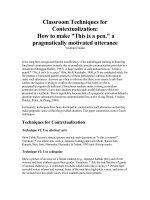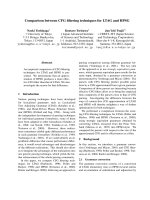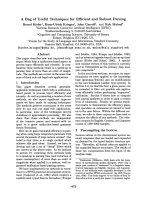500 creative classroom techniques for teachers and trainers by marlene caroselli
Bạn đang xem bản rút gọn của tài liệu. Xem và tải ngay bản đầy đủ của tài liệu tại đây (2.38 MB, 350 trang )
500 Creative Classroom Techniques
for Teachers and Trainers
Marlene Caroselli
Tomorrow's illiterate will not be the man who cannot read; it will be the
man who has not learned how to learn.
—Herbert Gerjuoy
HRD Press • Amherst • Massachusetts
Copyright © 2006 by Marlene Caroselli.
All rights reserved. No part of this publication may be reproduced, transmitted, transcribed, stored in
any type of retrieval system, or translated into any language in any form by any means without the prior
written permission of the Publisher.
Published by:
HRD Press
22 Amherst Road
Amherst, MA 01002
(800) 822-2801
(413) 253-3490 fax
ISBN 0-087425-922-3
Cover Design by Eileen Klockars
Editorial Services by Suzanne Bay
Production Services by Anctil Virtual Office
Marlene has given us an astounding array of creative ways to handle all the nuts and bolts of
participatory learning. This book will be an invaluable resource for anyone who wants to engage
learners and help them understand, remember, and apply what you have taught them.
— Mel Silberman,
author of Active Training and
101 Ways to Make Training Active
500 Creative Classroom Concepts is a treasure of proven, as well as practical training tips. Whether you are a
seasoned trainer or just starting out in the profession, you won't want to train another day without
these precious gems at your fingertips. I only wish I'd had the wealth of ideas this book offers when I
first started training. Thank you, Marlene, for a real prize!
— Elaine Biech
ebb associates inc
author of Training for Dummies
I have several of Marlene's other books and she has outdone herself in this delightful volume. The
book has a wonderful format, great content, passionate writing style, immediate applicability—and
brainteasers that keep my neurons, axons, and dendrites in shape.
Marlene has identified 20 critical tasks in a training classroom and provided 25 intriguing techniques
related to each. You can mix and match the powerful ideas to create your personal training style. Use
these techniques to improve your instructional and motivational effectiveness.
— Sivasailam "Thiagi" Thiagarajan, Ph.D.,
author of Design Your Own Games and Activities
Table of Contents
Introduction ....................................................................................................................................................... 1
An Investor’s Guide .......................................................................................................................................... 3
Chapter 1: 25 Ways to Have Participants Introduce Themselves ........................................................... 9
Chapter 2: 25 Ways to Test for Understanding ......................................................................................... 23
Chapter 3: 25 Ways to Add Humor............................................................................................................. 39
Chapter 4: 25 Ways to Give Feedback........................................................................................................ 53
Chapter 5: 25 Ways to Use Questions ........................................................................................................ 67
Chapter 6: 25 Ways to Use Quotations....................................................................................................... 81
Chapter 7: 25 Ways to Have Groups Report ............................................................................................. 97
Chapter 8: 25 Ways to Get Through Printed Material.............................................................................. 111
Chapter 9: 25 Ways to Choose Group Leaders ......................................................................................... 127
Chapter 10: 25 Ways to Fill "Odd" Moments.............................................................................................. 141
Chapter 11: 25 Ways to Deal with Reluctant Learners ............................................................................... 157
Chapter 12: 25 Ways to Make the Subject Matter Relevant ....................................................................... 173
Chapter 13: 25 Ways to Review ..................................................................................................................... 189
Chapter 14: 25 Ways to Encourage Participant Learning After the Course Has Ended ....................... 205
Chapter 15: 25 Ways to Encourage Managers, Principals, and Parents to
Continue the Learning .......................................................................................................... 221
Chapter 16: 25 Ways to Develop Study Habits............................................................................................ 237
Chapter 17: 25 Ways to Conduct Non-Threatening Competition ............................................................ 251
Chapter 18: 25 Ways to Make Take-Home Assignments Relevant........................................................... 267
Chapter 19: 25 Ways to Think on Your Feet ............................................................................................... 281
Chapter 20: 25 Ways to Develop Self-Confidence ...................................................................................... 301
Appendix
Collective Nouns ............................................................................................................................................... 325
Discussion Questions About Feedback ......................................................................................................... 327
Sample Grammar Test ...................................................................................................................................... 329
Sample Intuition Quiz....................................................................................................................................... 331
Selected Quotations on Leadership ................................................................................................................ 333
Thought-Provoking Proverbs.......................................................................................................................... 335
Sample Letters of Commendation .................................................................................................................. 337
A Training Checklist.......................................................................................................................................... 339
About the Author .........................................................................................................................343
v
Introduction
This potpourri of pedagogical practices culminates a lifetime of teaching—in kindergartens, primary
schools, middle schools, and high schools, in undergraduate and graduate school lecture halls, in
corporate training rooms, on military bases, and in auditoriums before multi-thousand audiences. These
experiences have created a very heavy “toolkit” that I am now eager to remove and turn over to others.
You, no doubt, already have a heavy toolkit of your own. If you bought this book, you are probably
one of those exemplary instructors who is always experimenting, always discovering, always evolving.
Like me, you are probably eager to share with others what you’ve done and what you’ve learned. Over
the years, I have exchanged ideas with student teachers, with colleagues, and with readers of my other
books, but nowhere have I presented 500 ideas all at once! (Actually, well over 1,000 when you add in
all the options on virtually every page and add the Appendix ideas as well.) This book is a compilation
of life-lessons for those teachers and trainers who are truly lifelong learners.
But the book is much more than tips and tools and techniques. It also provides information on various
learning-situation elements—skewed information, perhaps, but as S/
oren Kierkegaard observed,
“Education without bias is like love without passion.” You’ll hear my educational-beliefs coming
through: I don’t believe, for example, in long lectures. I’m opposed to death by PowerPoint. I think
people have to get involved in order to get educated. I prefer table groups to lecture-hall seating.
I believe, too, that someone has made an investment in the learner—parents, managers, the organization,
society, perhaps the learner himself. And investors want a return on their investment. This book has
been written to maximize that investment.
1
An Investor’s Guide
As a teacher or a trainer, you are investing in the learner—if only by way of the time and energy you
exert to improve your teaching techniques. Throughout this book, you’ll find improvement tips that
will make your teaching and their learning fun, fast-paced, and functional. Before we get to those,
however, here is a glossary of techniques and terms used in the book, as well as a checklist designed to
advance your improvement actions.
Participant Assignments. In addition to individual tasks, I will suggest using pairs, triads, teams, and
whole-group exercises to achieve various purposes. When the exercise calls for some type of revelation
or personal experience, pairs or other small-group formations work well. When role-plays are used (or
other exercises calling for an observer to note an interpersonal exchange), I suggest using triads. When
an exercise merits full-group attention, the best method involves speaking to the class as a whole
throughout a given exercise or for any one part of it. One option is to keep one-half of the class busy
while you teach the others “up close and personal.” Then reverse the process.
Quizzes. The element of surprise can be a powerful force in retaining new knowledge. Design quizzes
that both elucidate and educate. By juxtaposing what participants knew pre-quiz with what they learned
post-quiz, they can more quickly appreciate the width of the knowledge-gap. Other quizzes should be
designed to test the degree of retention or to determine the degree of comprehension. (I recommend
that you never ask any one participant how he or she scored on a given quiz. Additionally, never ask for
a show of hands related to scores at the lower end of the continuum.)
Handouts. These are designed to supplement the intent of the exercise and to reinforce the main
points being made. Handouts are also employed when participants need to have a common understanding of a situation, on the basis of which they’ll take further action.
As you prepare your handouts, keep in mind their future value. What can you do to prevent them from
being discarded as participants walk out the door? Design them so they will also be useful references or
resources in the future. Consider what is most critical and how it can most easily be presented. By now,
you know my biases regarding PowerPoint. Instead of handouts that are merely copies of your slides,
put some effort into creating handouts that reflect the instructional flow of your presentation—
handouts that contain summaries written in a conversational tone, perhaps, and exercises for future
practice.
Case Studies. Case studies, due to their real-world nature, enable participants to correlate their own
experiences with someone else’s and to project possible outcomes. When the actual outcomes are
compared to their projections, participants will then learn through discussion and analysis how best to
handle comparable situations if and when they occur in their own lives. There’s a safety net associated
with case studies—they reveal pitfalls without making participants take the actual steps into those pits.
By studying how someone else handled or should have handled a difficult situation, participants can
derive benefit that can later be applied to their own personal and professional situations.
Buzz Groups. There’s a definite “buzz” that emanates from a classroom filled with small groups
working on the same assignment and probably approaching it from different perspectives. Trainers can
3
500 Creative Classroom Techniques for Teachers and Trainers
optimize this excitement by establishing a few ground rules, among them the time element and the fact
that groups should try to keep their voices down so others can work more easily. Additional factors to
be considered include the following:
Selection of group participants. To avoid having people who see each other all day long sit together
all day in a training session, here are several possibilities for grouping (or re-grouping).
•
Have participants match well-known book titles with their authors. (In a group of 20 participants,
you’d have 10 titles and 10 authors.) Distribute these assigned roles as participants enter the room
and have the “titles” and the “authors” match up.
•
As participants enter, give each person a different-colored candy kiss. Then assemble groups based
on their colors.
•
Write the name of the course on each of three large sheets of heavy paper or cardboard. Divide
each sheet into irregular puzzle-pieces (seven or eight pieces for each puzzle if the class size, for
example, is 22). Cut the pieces for each sheet and put them in an envelope. Shake the pieces up and
then distribute one to each participant who enters the door. Have participants group themselves
according to the color they selected.
Storyboards. Storyboarding, like so many other creative processes, started with the Walt Disney
company. Today, the technique is used in meetings and training sessions around the world. You can use
storyboards to lead discussions, and participants can use them to execute their project.
If you’ve never used them for instruction, now is a good time to start. If you use them often, you know
their value in terms of focusing a group’s attention in a visual manner and generating discussion.
Typically, a four-foot by four-foot foam board is used with index cards and pins, but there are
numerous variations on this basic theme. Storyboards are used to track a process, to generate creativity,
to achieve clarity, to reach consensus, or to direct wandering attention to the problem
at hand.
You (or the group’s leader) will identify the purpose of the storyboarding task. Then provide relevant
information using index cards pinned to the storyboard or taped to flipchart paper. Class participants
or group members discuss the situation and jot down their ideas on cards, which are then arranged on
the board. If possible, plan a break of some sort, if only a mini-mini-lecture or a brainteaser.
Participants will need time for the ideas to settle and sink in before they return to the situation being
storyboarded.
Then, have them go up to the board and rearrange the cards that are on it until they are satisfied with
the answer or outcome.
Guided Discussions. You can design activities based on relevant articles or monographs that
participants read in class. (Ideally, these should be distributed prior to the class so valuable class time is
not taken up with background reading. The advance arrangement also prevents the “lag” that results
from people reading at different rates.) Once the group has internalized the material, you’ll discuss it
using questions that have been prepared ahead of time.
Scripts. Scripts bring out the creativity in participants. They also help participants develop insights
and convert theory to practical application. Scripts have a way of sharpening the distinctions between
4
Investor’s Guide
best-case and worst-case scenarios, and provide an interesting alternative to direct discussions of a
given point. (Note: Scripts need not always be acted out. Often, the mere exploration of ideas on paper
is sufficient to illustrate the point.)
Role-Play/Simulations. You’ll find some participants naturally hesitant to engage in role-plays. It’s
important for you to overcome that reluctance, though, because role-plays provide an instructional
value not afforded by any other method. Reluctance is usually tied to tension, a tension that results
when individuals think about being someone or something other than themselves. If unchecked,
tension can stultify creativity and can even block the natural flow of ideas.
One simple and quick way to relieve tension is to use the Y-E-S technique: Have the entire group
engage in a deep, satisfying, collective Yawn just prior to the role-plays. Then provide Education about
the value of role-plays (they help participants prepare for real-world encounters, they illustrate
significant points, and they can actually be fun). Also provide education regarding the specific
parameters of the roles and of the exercise itself. Finally, provide a few moments of Silence, during
which they can collect their thoughts (perhaps even jot down a few notes). Then . . . let the roleplays begin.
Another possibility is to refer to the activity without prefacing it with the words “role” and “play,”
which seem to concern some people.
Finally, provide guidance to the observers so that the debriefing sessions can have maximum benefit.
Have three or four questions ready—perhaps even written on the flipchart so the observers can lead a
discussion that benefits everyone.
For example, questions like these:
“If this role-play could be done a second time, what would you change?”
“Has a situation like this ever occurred in real life?”
“What other options/outcomes might have worked in this situation?”
Assessments. If it weren’t for training opportunities, some participants would never introspect. The
training environment is ideal for encouraging participants to take time to consider questions with
potentially far-reaching implications. These assessments invite self- and organizational analysis.
Panels. An interesting variation on the theme of knowledge acquisition is to use panels. Panels can be
composed of non-participants who are invited to the training room to present their views on a given
topic. Following this presentation, a question-and-answer session will bring effective closure to the
event. Panels, though, can also be composed of participants—volunteers or spokespersons selected by
their table groups to present summaries of the work that groups have just completed. Panel members,
representing the class as a whole, can exchange ideas on behalf of their groups. (An alternative would
be to have participants write additional questions for panel members and to have a moderator collect
these and present them to the panel for response.)
Fishbowls. This technique involves having one group work in the center of the room while the
remainder of the class sits in a wider circle around them, observing their interactions. It’s quite
effective, for example, for those in the center to simulate a meeting while the outside group observes
their interaction and effectiveness in dealing with the issue.
5
500 Creative Classroom Techniques for Teachers and Trainers
A Training Checklist
Included here is a list of responsibilities/recommendations that bespeak both professionalism and an
ethical commitment to the profession. Even if you are only an occasional trainer, I think you’ll find this
list helpful.
• I know this subject well enough to be considered something of an expert in it.
• I get to the room at least half an hour early to set it up and to greet early arrivals.
• I do all I can to make participants feel welcome, such as putting a welcome sign on the door or writing the word
“Welcome” on the flipchart.
• I make a sincere effort to learn about my participants, their work, their goals, their environments, and their strengths
and weaknesses.
• I begin with an introduction to the course, and provide an outline of my objectives and my credentials for teaching the
course. Then I follow with introductions of the participants themselves.
• I take care of “housekeeping” items at the beginning of class.
• I make participants aware of ground rules.
• I try to have all their names memorized before the first break.
• I am familiar with Howard Gardner’s seven intelligences and/or J.P. Guilford’s 124 intelligences and applaud more
than the verbal or mathematical proficiency of participants.
• I work to learn (and post) participants’ expectations for the course.
• I make sure there’s a relevant reason behind all tasks.
• I try to structure courses according to a philosophy like Jesse Jackson’s: “Put a floor beneath each learner and a ceiling
above none.” In other words, I make sure everyone possesses the basics before moving on to more-sophisticated
concepts.
• I actively work to make the learning experience an enjoyable one.
• I can integrate their views into the course material.
• I try hard to keep discussions on target.
• I present an overview or agenda of what the course entails.
• I benchmark with other teachers/trainers to ensure that I am providing the most valuable information in the most
relevant way.
• I am sensitive to diversity issues, including diversity in learning styles.
• I take pride in the professional look of my materials.
• I make deliberate efforts to structure activities to optimize the ABC’s—the Affective realm, the Behavioral realm, and
the Cognitive realm.
• I am aware of the “glazed-over” look characteristic of participants who are confused or overwhelmed by the material,
and make adjustments when I see it.
• I debrief after content-rich activities.
• I use anecdotes and continuously refine my raconteur abilities.
• I actively work to make the learning environment one of comfort and inclusion.
• I seek feedback throughout the session—not just at the end.
• I frequently invite participants to discuss their real-world situations in light of the learning that is occurring.
• I make myself available to participants before and after the class, as well as during breaks.
• I periodically review the material or provide summaries.
• I consciously avoid sarcasm, vulgarity, inappropriate humor, and references that may be offensive.
• I anticipate questions that will arise and prepare responses to them.
• I employ anecdotes to illustrate points.
(continued)
6
Investor’s Guide
A Training Checklist (continued)
•
•
•
•
•
•
•
•
•
•
•
•
•
•
•
•
•
•
•
•
•
•
•
I assure participants that they will never be made to feel uncomfortable.
I never lecture for more than 15 minutes at a stretch.
I incorporate humor into the presentation.
I include relevant news events and statistics in my presentation.
I am “physical” with the information—i.e., I make dramatic gestures from time to time.
I provide a change of pace on a regular basis.
I consciously think about ways to make the presentations interactive.
I encourage participants to meet and work with others in the room.
I invite feedback about the presentation.
I strive to relate the material to participants’ jobs, goals, and lives.
I schedule breaks as needed.
I make sure that the screen and flipchart can be seen by every participant.
I keep abreast of developments in the field.
I am familiar with Bloom’s Taxonomy and ask questions on all five levels.
I revise my materials on a continual basis.
I use media effectively.
I have not stopped honing my communication skills.
I employ a wide variety of methodologies.
I evaluate learning comprehension in a variety of ways.
I invite questions and feedback on my presentation.
I invite (but put limits on) the telling of “war stories.”
I provide ways for participants to be continuous learners.
I design effective closings.
Each of the twenty chapters that follow has its own Overview. For the sake of gender equity, the
masculine and feminine pronouns will alternate by chapter. Each chapter contains a wide variety of
tips, suggestions, options, cautions, F.Y.I tidbits, and recommendations. I’ve added brainteasers for a
post-activity change of pace. The brainteasers can be used at the beginning of the class to provide an
idea of the kind of brainpower amassed in the room; in the middle of a long activity, when you feel the
class needs a mental break; when you want to get their “cerebral juices” flowing after lunch; when you
have odd minutes to fill, and so on.
Note, too, that many of the techniques refer you to the Appendix, where you’ll find a number of
additional resources.
Einstein once said that love is the best teacher. I’ve loved preparing this compendium. I hope it teaches
you in the best ways possible.
7
Chapter 1
25 Ways to Have Participants Introduce Themselves
Chapter Overview
The first few moments of class are fearful moments for some participants. For others, the
introductions that take place at the beginning of a new program are sources of interest, of possibilities,
of discoveries, of commonalities. While it’s perfectly acceptable to ask people to give their names and
tell a little about themselves, the process often lacks luster. You can enhance it by structuring the way
you ask for atypical information.
What NOT to do: Don’t try to be a comedian unless you are one. Henny Youngman got away with an
introduction like this: “And now, the band that inspired that great saying Stop the music! ” Don’t try thinly
veiled insults. They seldom work.
In this section, you will find 25 novel ways for students to share information about themselves, about
their purpose for being in your classroom, and about the things they hope to learn.
1.
Use the course title.
Print the name of the course on the board or flipchart. Leave space between the letters. Then
ask each person to take one letter from the word and use that letter as the first letter of a word
that explains why he is taking the course or what he hopes to learn.
Example: If the course is about supervision (S-U-P-E-R-V-I-S-I-O-N), you might take the
letter ‘I’ and use it to introduce yourself in the following way: “I pride myself on being an
intelligent person. Intelligence means always gathering new information. I’m here to learn as
much as I can.”
Brainteaser: There are eight learners in a room. Each one shakes hands just once with each
of the other learners. What is the total number of handshakes?
Answer: 28. Gather seven other people and start shaking hands if you don’t understand why the answer is 28.
9
500 Creative Classroom Techniques for Teachers and Trainers
2.
Test their intuition.
Have each person give his name and make a statement about his confidence in his own intuitive
powers or a statement regarding the degree to which he relies on those intuitive powers. Then
tell the group you are going to give a quiz that will test their intuition. (Make up one of your
own, or use the one provided for you in the Appendix.)
Chances are, they will do very poorly. If you use the Appendix quiz or one like it, go over the
answers and then ask if anyone had a score higher than 60%. Very few will have so high a result.
Use the opportunity to stress the importance of keeping an open mind and being willing to let
go of preconceptions so new concepts can replace them.
Brainteaser: What is the first number starting with zero and continuing with whole numbers
in ascending order that, when spelled out, has all the letters of that word in alphabetical order?
Answer: Forty.
3.
Challenge them to tell why the course is important.
If the class is working in table groups, give them this assignment: “Come up with at least one
situation or reason why the information in this course will be/can be important to you.” They
can speak in individual terms (e.g., to get a passing grade so they can graduate) or in more global
terms (e.g., the better we are at communicating, the less chance there will be for discord).
Have each group start off their report by giving the names of the members. Then, as they
present their situation or reason, list it on a flipchart. The totality of the responses will help
reinforce your objectives for the course.
Option: On a flipchart or overhead, list as many concepts as you can. Have individuals or pairs
select the one concept they’d be most interested in learning. Place a check mark beside each
item as the responses are provided. Then make this promise: “I’ll spend more time on the most
popular than on the least popular. However, I reserve the right to drill, drill, drill on an
unpopular-but-important (in my opinion) concept.”
10
Chapter 1: 25 Ways to Have Participants Introduce Themselves
4.
Assign partner-interviews.
Start by showing how a dull interview question generally elicits a dull answer: “How long have
you been teaching?” “Twenty-four years.” By contrast, a question such as “Of all the students
you have taught over the years, who stands out in your mind the most?” is bound to yield the
vivid memory of an obviously unforgettable character.
Allow a few minutes for participants to devise an interesting question. Once each person has
had a chance to interview a partner, begin calling on them to tell two things only: the partner’s
name and the single most-interesting thing about him.
Brainteaser: What three letters can be used to spell three different words when the letter and
the two missing letters are arranged like this?
L
L
L
Answers: Pal, Alp, Lap.
5.
Give participants a choice of questions to answer.
Demonstrate creativity from the get-go. Have a list of questions written on the flipchart or
overhead. (PowerPoint them, if you must.) Then have each participant choose two and respond
to one of them. (Note: Classes have a tendency to choose questions at the beginning of the list.
To avoid monotony, insist that they answer their second question if too many responses are
provided for any one question.)
Here are some interesting possibilities:
Of all your unforgettable memories, which one would you like to forget?
If your life were a television channel, such as a history channel, what would it be and why?
What famous person are you most like?
If you were principal of this school (or owner of this company), what one change would you
immediately institute?
What is your favorite word? Why have you chosen it?
What correlations can you make between chefs and lions?
Other than picking teeth, what can a toothpick be used for?
What is one question you can’t answer?
11
500 Creative Classroom Techniques for Teachers and Trainers
6.
Have them explain why they’re studying this subject.
As each student gives his name, he will also be asked to tell what he hopes to learn from the
class or what his boss wants him to learn (or what his parents want him to learn, if the setting is
a school setting). Stating their purpose for being there helps students to focus on the class and
the learning they have a responsibility to acquire.
Brainteaser: What letter—clearly, visibly, obviously—is out of place?
Answer: T. It is bigger and its lines are bolder than the other letters.
7.
Make them think: What future use can they make of what
they’re about to learn?
This is an especially challenging assignment—so difficult, in fact, that you may want people to
pair up to provide a response. Have each person give his name and then identify one specific
future use for the information he will be acquiring. (Note: It’s important for them to write their
future use on a sheet of paper and then to read from that paper. Otherwise, you will find
everyone parroting the responses of the first person.)
Leadership-class example: “I’m hoping to establish an Adopt-a-School program for the
people in my department and a nearby elementary school. Given how busy people already are, I
know the proposal and its acceptance will require real leadership. I hope this course provides me
with effective ways to influence people to take positive action.”
Brainteaser: What letter belongs in the blank?
OTTFFSSE
Answer: N. The letters represent the first letter in the spelling of the numbers from one to nine.
12
Chapter 1: 25 Ways to Have Participants Introduce Themselves
8.
Let them critique you.
Education is all about change. All about moving from the darkness to the light. All about
(literally, from the Latin) leading ourselves and others out of the present and into an altered
state. Encourage your students to help you re-engineer yourself and introduce themselves at the
same time.
Ask them to think about the best teacher they ever had, and to isolate one specific thing that
teacher did that was memorable.
Then, call on each person to give his name and to complete this sentence: “I hope you will do
what my favorite teacher did: he used to . . .”
Brainteaser: What letter belongs in the blank?
DJ FM AM JJ AS O
Answer: N. The letters represent the first letters in the names of the months, starting with December.
9.
Task the group with collecting knowledge.
A mind is a terrible thing to waste. So is time. By asking your table groups to record everything
they already know about the subject, you’ll learn what they’ve already learned. Thus you can
make some quick, if subtle, adjustments to the plans for the day.
This activity will take at least 15 minutes, depending on the size of the group. Each person will
tell what aspect of the course he has mastered. As they share their expertise, participants will
have a chance to get to know others in their table group first. A spokesperson can introduce
group members via a report that highlights the collective knowledge they possess. Poetry class
example: “I’m Jerry. Among us, we have expertise in the haiku, the cinquain, the sonnet, and
scanning techniques. And we have one person so enamored with Shakespeare that she even
knows his birthday is April 23!”
Brainteaser: More of a brain-improver, this exercise develops both concentration and rapid
thinking. Take five words (or ten, for a real challenge) of five letters each. Separate the letters in
each word and combine them (first + first, second + second, et cetera), as shown below.
Exchange with someone who has done the same thing. Time yourself, trying to better your
“score” each time (the score is really the time required to figure out the words). Or assess
yourself by comparing yourself to your partner: whoever finishes first is the “winner.” (Note:
The words can also be five letters each or seven letters each. I’ve chosen words of six letters for
this exercise.)
(continued)
13
500 Creative Classroom Techniques for Teachers and Trainers
9. Task the group with collecting knowledge. (concluded)
Example: If I were to write the word “cat” with each letter bracketed on the left, you
would have no trouble recognizing the word: [ c [ a [ t. And if I were to write the word “dog”
with the brackets on the right, you’d still be able to see “dog” quite easily: d ] o ] g ]. But
when I combine these two bracketed words, it’s suddenly much more difficult to see
them: [ d c ] [ o a ] [ g t ].
In the brainteaser that follows, two six-letter words have been combined the way “dog” and
“cat” were combined in the example. Time yourself as you look for the ten words.
1. [c a] [a s] [r s] [p u] [e r] [t e]
Words:
__________ and __________.
2. [r p] [e e] [c n] [o c] [r i] [d l]
Words:
__________ and __________.
3. [d h] [a o] [n u] [c s] [e e] [r s]
Words:
__________ and __________.
4. [a f] [n i] [k n] [l g] [e e] [s r]
Words:
__________ and __________.
5. [c s] [o t] [u a] [p p] [o l] [n e]
Words:
__________ and __________.
Answers: 1. “carpet” and “assure” 2. “record” and “pencil” 3. “dancer” and “houses” 4. “ankles” and “finger”
5. “coupon” and “staple”
Brainteaser: Ready for more sports-team puzzles?
1. Artful ones from the city of Hispanic cherubs
2. Druids from a leguminous location
Answers: 1. Los Angeles Dodgers 2. Boston Celtics
14
Chapter 1: 25 Ways to Have Participants Introduce Themselves
10.
Give one course-related word as a prompt.
Hone your own thinking about what you teach by pulling the gist of it from your gray matter.
Choose a single word that encapsulates the course material. The word, ideally, will be a familiar
one; use it to stimulate thinking about phrases that contain that word.
Example: In an art class, you might use the word “red,” which is important as a primary color.
Task table groups with creating lists of phrases that contain the word (“red-letter day,” “seeing
red,” “Hunt for Red October,” and so on). For a class in management or supervision, the word
could be “lead.” The related expressions might be “leading with your chin,” “follow the leader,”
“You can lead a horse to water . . .”
Then ask groups to introduce themselves and share their lists. Encourage them to listen so
carefully that the second (and subsequent) groups do not repeat any of the phrases used by
preceding teams.
Note: if your chosen word does not elicit a long list of phrases or if there’s too much repetition,
have subsequent groups explain some of the terms or give examples of how one phrase might
pertain to the course.
11.
Tell them to find an object that symbolizes themselves.
If you will be meeting with the group more than once, just have participants give their names at
the first session. For the second session, they are to bring some object that symbolizes who they
are. At the very beginning of the second day, call on each person to use his self-symbol to
introduce himself and explain why/how the object represents him so well.
Example: You could start the process by holding up a pencil and saying something like this,
“Some of you will consider this pencil old-fashioned, compared to the speed with which you can
produce words on a computer screen. And I suppose I am old-fashioned, but I still like this
pencil as a self-symbol. Notice it’s straight and narrow. I try to stick to the straight and narrow
in my own life. Notice, too, that it has an eraser. This symbolizes mistakes I have made and my
willingness to learn from them and move on.”
Option: If the class is only being held for one day, ask participants to think of all the objects in
their homes. Then, they are to select one and simply tell the class how the object reflects their
personality, values, interests, et cetera.
15
500 Creative Classroom Techniques for Teachers and Trainers
12.
Ask for truth and lies.
Each participant will tell three things about himself, one of which will be a lie. You, as the
instructor and official lie-detector, can guess which is the lie. Every time you fail, award the
participant a small knowledge-prize. The alternative is to call on various other class members to
guess which statement is not true.
Option: Have participants tell a story regarding the subject matter and a time when their
knowledge of the subject proved to be beneficial.
Brainteaser: What number does not belong with the others?
3810
6024
4816
1452
Answer: 4816. The other numbers within each number yield 12.
13.
Use pennies as prompts.
Give participants a penny or two each, and then divide class members into groups. Each person
will tell the group something about the year written on his coin—if only the fact that it was
minted 20 years before he was born (as might be the case with young participants). The coins
should stimulate some interesting discussion about American (or personal) history.
Then ask them to choose a name for their group, based on the most interesting yearinformation they heard (for example, “The Fabulous Forty-Niners”). Pass out a sheet of
flipchart paper to each table group. Ask them to write their group name, the names of the group
members, and then a statement related to history or to the group’s personality. After 15 or
20 minutes, have each group report and then post the papers around the room.
Brainteaser: What three letters can be used to spell three different words when the letter and
two missing letters are arranged like this?
R
R
R
Answers: rat, art, tar
16
Chapter 1: 25 Ways to Have Participants Introduce Themselves
14.
Provide examples of “try-umphs” and ask them to write
their own.
Learning ain’t what it used to be. The law school model of study groups has moved beyond the
legal classroom. More and more learning situations today have students studying together—
proof that the point is to gain knowledge (perhaps in order to pass an exam) and not to compete
with one another.
To this end, ask participants to work with at least one other person. The teams are to come up
with a three- or four-word statement that is a positive affirmation of the learning experience.
The statement should suggest what they will try to do and add the “umph” factor to their
efforts. They will use their try-umphs to introduce themselves.
Sample try-umphs:
15.
Just do it. (Nike ad)
Just say “no.” (Theme of an anti-drug campaign)
Drive out fear. (Dr. Edwards Deming)
Eliminate turf wars. (Dr. Joseph Juran)
Never give up. (Winston Churchill)
Quote Drucker. Then ask them to ask questions.
Management guru Peter Drucker maintains that leaders know how to ask questions—the right
questions. Ask each person to think of a question they’d like to ask you and to then introduce
himself and ask his question.
If the class is large, divide the questions and the responding time in half by pairing up
participants.
Brainteaser: What do these words have in common?
red, pink, gray, brown, black
Note: Participants will immediately respond that all the words are colors. Keep pushing them
to find additional similarities.
Answer: The words are also all monosyllabic. They all end in a consonant. They also all start with a consonant. Each has
only one vowel. Each has another word contained within (“Ed,” “ink,” “ray,” “row,” and “lack.”).
17
500 Creative Classroom Techniques for Teachers and Trainers
16.
Have them speculate about the agenda.
Have each small group make a list of what they think will be covered in the course on this day.
Then have a spokesperson give the names of the people in his group and also the items on the
group list. Wait until each group has provided its list. Then award a knowledge-prize to the
group that comes closest to the agenda you have planned for the day. The group also wins the
opportunity to put their list on flipchart paper and hang it on the wall.
Brainteaser: Which pair completes the analogy?
Note: The colons indicate the relationship. Instead of saying “short is to tall as small is to big,”
the analogy question would be written this way: “short : tall : : small : big.”
Note : Eton : : a) school : dean
b) paper : pupil
c) message : school
d) time : emit
Answer: D, because the original (note: Eton) has two palindromic words, as does the last entry.
17.
Activate change in their learning.
Write these letters and words on a flipchart, transparency, or PowerPoint slide.
C = Concentrate
H = Habit
A = Attitude
N = New habit
G = Grow
E = Educate
(What will they concentrate on learning today?)
(What old learning habit do they want to break?)
(What attitude best serves knowledge acquisition?)
(What new learning habit would they like to acquire?)
(How do they intend to grow as a result of this course?)
(Who else can they educate about this course?)
Then have each person stand, give his name, and respond to one of the questions.
Brainteaser: Which letter does not belong?
NYFMHKZ
Answer: M, because all the others require three strokes to make (M requires four).
18
Chapter 1: 25 Ways to Have Participants Introduce Themselves
18.
Help them define the course.
Quality guru Phil Crosby once remarked that if you ask 100 different people in a given
organization to define the word “quality,” you might get 100 different definitions. To achieve
consensus on an important course concept, ask small groups to define on chart paper a key
word associated with the course.
Then ask a group spokesperson to give the names of each group member and then read the
group’s definition before posting it. Once each group has shared its definition, have the class
vote on the one that best captures your intent (your vote is worth 50%). Then use that as the
operative definition for the day.
Brainteaser: Which city is least like the others?
Seattle, Wichita, Dallas, Atlanta
Answer: Dallas, because it is a two-syllable word and the others have three syllables. Dallas is also the only word that does
not have the letter “t.”
19.
Involve them in their own learning.
Ask table groups to prepare lists of what they believe to be the Seven Habits of Highly Effective
Learners. Post the lists. Then have every participant circulate around the room to look at the
posted lists and select one habit or trait that he possesses. When everyone has returned to their
seat, call on each person to give his name and the specific habit he is proud to possess.
Brainteaser: What is the pattern in this arrangement?
86
11
4
90
1
7
16
12
28
Answer: The numbers are arranged in the alphabetical order of the spelled-out words.
19









